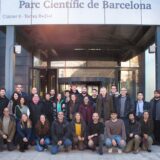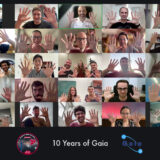SPACIOUS Initial Call for Early Test Users
SPACIOUS is an European project coordinated by the Gaia Barcelona team. SPACIOUS is a new cloud-based platform designed to support scalable, interactive, and reproducible workflows for data-intensive astrophysical research. Built to enable advanced analysis of large and complex datasets, SPACIOUS lowers technical barriers and provides the community with cutting-edge tools and infrastructure. SPACIOUS will officially launch its Open Call for Resources in September 2025. To prepare the community and refine science-driven use cases, we are now issuing this Initial Call for Early Test Users....
read moreGaia spacecraft passivation
Gaia colleagues gathered at ESOC (Darmstadt) on the 27th of March to send the Gaia spacecraft off into its retirement. Xavi Luri, Carme Jordi, Claus Fabricius among others from Gaia Barcelona were at the celebration of the very successful Gaia spacecraft. Gaia’s orbit around Lagrange point L2 can no longer be maintained without propellant, hence Gaia was moved into a heliocentric orbit, away from other spacecraft observing the Universe from L2 and avoiding close proximity to Earth. After Gaia’s insertion into its final orbit, the spacecraft was successfully passivated....
read moreNew Gaia Barcelona group picture
On the occasion of celebrating the almost 11 years of Gaia data, the Barcelona Gaia group held a lunch together with 32 participants, only a few missed it.
read moreMemory game
You want to train your memory? Gaia mission can help you with that while having fun!! The game consists in 2 copies of 20 different images, in total 40 cards with images related with the Gaia Mission. The aim of the game is to match up the identical images. You can play this game online: https://gaia.ub.edu/memory/ Steps: Each player turn a pair of cards up in their turn in order to locate the two identical cards. If identical images are found they will remain uncovered and the player has another turn. Otherwise, both cards will be hidden again and the player loses the turn. You must try to...
read moreCelebrating a Decade of Success of the Gaia Mission
The 25th July 2024, at 00:30 CEST, the Gaia satellite reached a historic milestone by completing 10 Julian years of uninterrupted and successful science operations. This anniversary marks a decade of astronomical achievements, exceeding the most optimistic expectations. Since its launch, Gaia has collected more than 2.5 billion astrometric data, more than half a billion photometric data, and nearly fifty billion spectroscopic measurements. The Gaia Barcelona group has been a key participant in the Gaia mission since its inception, contributing both on the technical side and in the scientific...
read moreCarme Jordi and Josep Manel Carrasco on “Recerclip espacial”
Recerclip espacial! “Laura Grau, Joan Oró i els misteris de l’univers” (in Catalan) https://youtu.be/5OY3TOovLRQ Video #Recerclip: Laura Grau investigates about the Joan Oró telescope at the Montsec Observatory (IEEC), with interviews to Kike Herrero (IEEC), Josep Manel Carrasco (ICCUB-IEEC), Nadia Blagorodnova (ICCUB-IEEC), Lluís Galbany (ICE-IEEC) and Carme Jordi (ICCUB-IEEC).
read more










